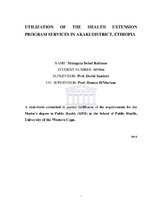Utilization of the health extension program services in Akaki district, Ethiopia
Abstract
Introduction: The Health Extension Program (HEP) is an innovative, community based comprehensive primary health care program that Ethiopia introduced in 2003. It gives special emphasis to the provision of preventive and promotive services at community and household level. However, utilization of the HEP packages is low and reasons for this underutilization are not well known. Aim: The aim of this study is to assess the availability and utilization of the Health Extension Program Service in Akaki District of Oromia Region, Ethiopia. Methodology: Quantitative study using a cross-sectional survey design. The study was conducted in Akaki District of Oromia Regional State in Ethiopia with 79,162 inhabitants. Random sampling was used to select 355 households. A structured data collection tool/ questionnaire was employed to collect data from the study participants.
Data were analyzed using SPSS for Windows version 19. Descriptive statistics were used to analyze socio demographic characteristics of the study participants and to assess the availability and utilization of each service component. Result: The response rate of the study was 100% with complete data obtained from 335 (94.4%) of the households. The majority (93.1%) of respondents were women. The availability of HEP services as described by the household visit of Health Extension
Workers (HEWs) is very high with 86.6% visiting at least monthly and 11.3% visited sometimes. There was a highly significant association between the health extension workers’ visit to households and health extension service utilization during pregnancy (OR=16.913, 95% CI 8.074-35.427 at p<0.001). HIV testing utilization showed a tenfold increase among households who received education. Participation of households in the Model family initiative was another key factor associated with high levels of HEP services utilization. Conclusion and Recommendations: Though HEP services are available for most households, the frequency of household visits by HEWs and the involvement of Households in model family training greatly influenced service utilization. Improving frequency of services availability at household level and consistent health education will greatly improve services utilization.

